Timothy Riesterer's Blog, page 13
January 31, 2018
Recording Yourself to Record Performance

You may not be a golfer, but you know an awkward swing when you see one. You’ve probably never acted in a movie, but you can easily spot bad acting.
If you think recording yourself in sales character is weird, or narcissistic, get over it. It’s the best way to prepare to excel in the moment during customer conversations. And, it can even serve as the foundation of a training approach that, through a system of expert coaching and feedback, turns observable practice into demonstrated proficiency.
You Sound Different Than You Think
When it comes to customer conversations, and nimbly navigating the twists and turns that can unexpectedly arise, it’s all about repetition. Most people inherently know this. Few sellers actually live it.
Musicians have long known you sound different than you think. Playing an instrument, like selling, is so difficult in itself that listening objectively to the chords you’re playing or the melody you’re singing often takes a back seat.
When you record yourself, you can experience the conversation from the perspective that matters most—your customer’s. Do you periodically pause to allow your customer to participate? Does your narrative speak to them, or about you? How expressive is your body language or vocal tonality? Are you correctly articulating and emphasizing the most critical junctures in your story?
Most importantly, ‘Would you buy from you?’
How Fluency Coaching Works
Consistent with an evidence-driven approach to skills development, Fluency Coaching in the form of recorded practice is directly integrated into your learning plans. Here’s how it works:
Reps receive structured challenges, linked to the skill areas they’re discovering. For example, winning access to a customer executive. They simply record, then submit their response to receive individualized coaching and feedback. Within target completion dates the entire process can be completed at each rep’s convenience so as not to be disruptive to core responsibilities. That flexibility is critical today. A Corporate Visions survey found that the number one reason companies struggle to train as many reps as they want is a reluctance among sales managers to take reps out of the field for training.
When using recordings, sellers often record multiple takes before finally submitting one they’re happy with, accomplishing the oft-elusive goal of getting reps to practice.
Video recordings offer the richest experience, but audio-only recordings are also effective for developing skills like leaving compelling voicemails. Expert consultants can then review submissions and provide a depth of seller-specific feedback that’s difficult to replicate in group classroom settings—whether in-person or virtual.
Metrics produced through Fluency Coaching can also be aligned with manager evaluations of their teams, CRM-sourced performance data, and additional assessments to build a rich view of individual and team capabilities from which to match custom learning paths and close skill gaps.
How You Can Start Using Recordings
You can begin to incorporate use of basic practice recordings to encourage behavior change and build skill adoption using tools as basic as mobile phones. Best practices to ensure you achieve desired outcomes include:
Providing a good example(s) for reps to draw from and enrich their learning experience
Creating a rubric to produce consistent scoring – and exposing it to your reps too
Crafting challenges around actual accounts and opportunities, not case study scenarios
Rinse and Repeat
When you incorporate recorded fluency coaching into your development plans, the ancient Latin saying, Repetitio mater studiorum est, repetition is the mother of all learning, finds brand new relevance in the twenty-first century. I’m sorry, could you say that one more time?
Want to learn more about a virtual training program based on observable practice and demonstrated proficiency? Check out our latest State of the Conversation Report.
The post Recording Yourself to Record Performance appeared first on Corporate Visions.
January 16, 2018
Why Virtual Training Needs a Rethink
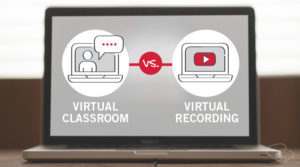
Training connoisseurs are pretty consistent when listing the pros and cons of virtual and onsite learning options. Here’s a simplified version of what you might hear:
Virtual pros: It’s cheaper, highly scalable, and less disruptive to schedules
Virtual cons: It’s less engaging, thus multi-tasking can impinge on learning
Onsite pros: It’s the right learning environment for optimal absorption
Onsite cons: It’s time consuming and expensive
The industry has put these options in black and white terms; the cons of one are the pros of the other. And there are a ton of assumptions embedded in this thinking. In fact, they’re all assumptions. Luckily this is also an industry filled with innovative minds, eager to challenge the notion that virtual learning isn’t engaging enough to capture (and keep) an audience’s attention.
Thanks to these bold minds, we chunk eLearning into bite-sized content, produce high-quality video, make characters come alive through fancy graphics, gamify everything, and salivate at the thought that one day soon, virtual reality will make simulations soar.
But for all the focus on challenging the engagement assumption, consider the fact that people don’t always get through an entire YouTube cat video before launching into Jimmy Fallon’s latest lip sync battle. Given that even the most engaging internet stars haven’t solved the online attention deficit problem, it’s highly unlikely the business training world will. That’s okay, and it doesn’t mean we should stop trying. It’s a worthy and fun battle to fight.
But we need to push harder on the industry’s most sacred assumption by asking the following: Why do we keep chasing the idea that part of the answer is to replicate the onsite experience in a virtual classroom?
After all, it’s not like virtualizing onsite learning will automatically eliminate the traditional format’s imperfections—in fact, doing so could even make some of their deficits more pronounced.
Every classroom trainer knows her students check out during post-lunch food comas. Group exercises really mean a few students do the work while at least one student punts. Every break is spent glued to a phone screen rather than allowing the mind the space it needs to reflect and commit to memory the lesson just learned. And the one-to-many classroom model leaves very little room for one-on-one attention and coaching.
So remind me again: Why are we trying to replicate the onsite experience in a digital environment?
The answer is pretty simple. We know it’s not perfect but it’s the best we’ve got. And now that we’re standing on the precipice of the onsite classroom’s future, the words to the Passenger song come to mind: “Only know you love her when you let her go.” Our comfort and familiarity with onsite training has likely caused us to build the wrong kind of virtual learning experience.
A Different Path for Virtual Training
Most learning professionals recognize that recreating the one-to-many onsite lecture environment in a virtual classroom is only remotely effective if all participants are on video. But that whittles away the scale benefits. And every participant still needs to be available on the same days and times. So much for time and schedule flexibility.
Why not start with an asynchronous, one-to-one coaching model? Let the eLearning modules handle the knowledge transfer, elevate the value of the trainer to mentor/coach, and make the whole thing self-paced? In an asynchronous, one-to-one environment, you can assign learners relevant challenges at their desks, forcing them to integrate concepts directly into what they’re working on that day.
In the case of a salesperson, that assignment could be to plan a scheduled conversation with a prospect and record herself on video using the principles she learned in the eLearning modules. With a sales expert ready to critique her performance, there is nowhere to hide. The rep can’t rely on group members to do the work and there are no artificial, in-room time constraints to excuse a lackluster performance. If she doesn’t demonstrate that she can apply what she learned, she doesn’t complete the course. Her coach gives her direct, individualized feedback to identify areas of improvement and assigns remediation modules specific to her needs. And you maintain healthy competition by showcasing the top performances amongst colleagues.
When so much rides on the quality of what your salespeople say in front of your most important prospects and customers, why not establish a training environment built around observable practice and demonstrated proficiency?
With this level of accountability, you ensure learners don’t just log off after half-listening to a WebEx session and consider their training box checked. Each learner must demonstrate the behavior you’re seeking. That’s something you simply can’t do by trying to replicate onsite training in a virtual instructor-led training classroom.
Online, recorded fluency training may seem like a radical break from the in-person, event-based classroom model that’s long been the standard of the training world. But it’s actually a doubling down on what sales training has always been about: fluency, command, and positive, lasting behavior changes. What sales training approach wouldn’t want to aspire to those ideals?
The post Why Virtual Training Needs a Rethink appeared first on Corporate Visions.
December 12, 2017
Answering the “Why Now” Question

A sales rep at a medical equipment company recently told me he lost a deal for an MRI machine, not to another MRI competitor, but to a “parking lot.” I’ll explain.
When I asked him what he meant, he explained that the hospital executive he was working with decided they could improve patient throughput, satisfaction, and revenue if they spent $1 million updating their parking lot instead of purchasing a new MRI machine. This story illustrated to me that when executives get involved in purchase decisions, there are far more considerations that enter into the buying process—and far more “competitors” for the budget you’re seeking than you may realize.
That ups the ante for your proposals quite a bit, and it means you need to make a business case that’s even better at creating urgency and demonstrating impact—two areas in which many salespeople struggle today.
In part one of a two-part series with the Journal of Sales Transformation, I looked at where business proposals are falling short and failing to create the urgency needed to answer the following question executives are asking: Why should I buy now?
This follow-up piece looks at the research simulation Corporate Visions conducted with a professor at the Warwick Business School to determine the most effective message for the “why now” moment—when you need to make an impact with buyers who might not care how your products and services work, but want to know how you can help them drive business value.
Check out the part two of the article: “What Gets Executives to Act?”
The post Answering the “Why Now” Question appeared first on Corporate Visions.
November 24, 2017
Sales Strategy: What’s Most Effective? A Great Message!

When you think about it, an effective sales strategy is all about making sure that your reps hit their quota, right? Consider the following insights:
Research performed by SiriusDecisions shows that the number-one inhibitor to sales achieving quota is “inability to communicate value message.” In other words, if your sales force cannot communicate why your solution is different, better and worth more, there’s nothing your sales strategy can do to fix that.
In corresponding research in which SiriusDecisions asked executive customers about the quality of interactions with salespeople, only 10 percent said sales calls provide enough value to warrant the time they spent on them.
A Forrester Research study revealed that only 15 percent of sales calls add enough value, according to executives surveyed.
The Forrester study also showed that just 7 percent of surveyed executives say they would probably schedule a follow-up.
The lesson from these statistics is that the messaging element – what salespeople say, do, and write in order to create perceived customer value – is far from adequate. To be effective, your company sales strategy needs to focus on customer conversations as a way to create a distinctive purchase experience and separate your company from the competition. To do that, your sales strategy needs to focus on three key areas.
Sales Strategy Key #1: Demonstrate Value
We all dream of the situation where the prospect has already recognized and wants to solve the problem that your solution addresses. In this selling environment, you don’t need a winning sales strategy and message. But too often, you are not in a great selling environment and you need to work the prospect from every angle. You need to create opportunities. And to help prospects see the value of your offering, you need to tell stories with contrast. You need to tell both the “before” and “after” story – and it’s the contrast between the two that creates a powerful perception of value. The bigger the contrast you create between the “pain” the customer experienced before your solution and the “gain” the customer experienced with your solution, the greater the perceived value.
Sales Strategy Key #2: Position and Differentiate
Most technology companies position themselves for a competitive bake-off of features and benefits. They talk about “why us?” But the real questions that customers are considering are “why change?” and “why now?” Successful sales strategies require a new approach for positioning and differentiating your offering. To stand out from the crowd, you need to understand that your real competitor is the status quo and that you need to help your prospects make the decision to change before you help them make the decision to choose you.
Sales Strategy Key #3: Tell a Compelling and Memorable Story
When salespeople prepare for conversations with prospects, they usually focus on getting all of the facts straight about their offerings. And certainly, you need to be accurate in what you say about your solution. But you also need to connect with your customers – and the best way to do that is through stories. Telling personal stories, as well as using metaphors and analogies, helps bring your message alive in a way that reciting facts and data simply cannot. Once you start sharing stories as part of the way you talk to customers, you’ll see relationships change. Your customer relationships will be deeper and more rewarding.
Corporate Visions can help your company create a sales strategy on a solid foundation of effective sales messages. Power Messaging helps your sales reps execute the most remarkable, memorable and compelling buying experiences that convince prospects to choose you.
The post Sales Strategy: What’s Most Effective? A Great Message! appeared first on Corporate Visions.
November 16, 2017
Is Your Sales Kick-off “In Context”?

Getting your sales team fired up and ready to win is the goal of every sales kick-off. Why, then, does it seem like every year ends up as the same set of product-based breakouts where your salespeople learn all about what they’re selling, but not how to actually sell them across the range of scenarios they face?
It’s time to put your sales kick-off in context. That means addressing the many different types of selling situations your salespeople face, and giving them the right messages, content and skills to meet the distinct requirements those situations present. This eBook, Putting Your Sales Kick-off In Context, shows you how to create situational training experiences for four critical selling situations that take place across the buyer’s journey.
Learn what skills and techniques you need to address in training breakouts for when your salespeople need to:
Disrupt status quo bias and convince prospects to change
Create enough differentiation to protect premium pricing
Build consensus among executive decision-makers for complex solutions at higher price points
Ensure renewals and communicate price increases
Get the eBook: Putting Your Sales Kick-off In Context
The post Is Your Sales Kick-off “In Context”? appeared first on Corporate Visions.
November 10, 2017
Why You Should be Whiteboarding

We’ve all heard the term “Death by PowerPoint.” This has become a common way to describe the lack of interactivity and boredom engendered by typical slide presentations. I heard another one the other day, “waterboarding by Powerpoint” when someone compared it to whiteboarding.
It makes for an interesting (albeit questionable) alliteration but makes the same point. If you want to engage the crowd, while standing out from your competitors, slides aren’t the answer.
Here are five ways salespeople can boost performance using “visual storytelling” instead of slides. Whether using a whiteboard, a flip chart, the back of an envelope or a tablet PC via desktop sharing software, you can integrate the visual storytelling model into your marketing and sales messaging approach as a powerful differentiator in competitive and complex selling environments.
1. Develop a Powerful Whiteboard “Story” Instead of Bullet Points
Your presentation should be much more than just a list of bullets. It should be a compelling visual narrative designed to showcase your products and services and how they deliver unique value. For example, you could create a story about a “tragic hero” (an anonymous customer) who overcomes adversity (the current situation) to attain ultimate glory (the desired state, achieved uniquely by your solution/service).
The story also needs to be visually intriguing, with interesting iconography and should have a script that goes along with each step. The whiteboard story should include planned “interaction points” where you’ll engage with the customer to ensure a two-way dialogue. Stay away from features and benefits, specifically asking and helping answer these two questions: What’s the impact of sticking with the status quo, and what’s the value of making a change?
2. Stick Figures are More Powerful than Photography
One way people have attempted to fix the PowerPoint problem is by using large photographs and metaphorical imagery with just a couple words on the slides. While this may help make a keynote speech more interesting, it doesn’t advance the cause in a sales cycle. It doesn’t make abstract ideas more concrete, and it doesn’t make complex concepts simpler.
Stick figures. Boxes, circles, arrows, dollar signs. Stuff you can draw. And, images that tell a story. Even more importantly, these hand-drawn visuals can be re-drawn by your prospects after you leave the room. You want your story to “walk the halls” in your absence, right? You want your prospect to feel smarter and more empowered to promote your story, right? Well then give them the gift of a simple story and visual that helps them understand and react, as well as own and distribute.
3. Visual Storytellers are more Consultative
With the visual storytelling approach, it’s essential that you immerse yourself in the content. Prospects perceive salespeople with a clicker in their hand as “PowerPoint jockeys.” You are telling a story that someone else created. A visual story that you draw, and explain along the way, gives you the credibility. It confers the knowledge and expertise to you, not the Marketing department that created the pretty slides.
In a world where every salesperson wants to be a “trusted advisor” or practice “consultative selling” visual storytellers are seen as adding more value. Facilitating more engagement. Delivering insight and expertise. Getting the room to think about their challenges and opportunities in a fresh and interactive way. Turning on the lights and taking a pen in your hand, as opposed to closing the shades and standing in the shadows of the projector create an entirely different perception of you and the role you are playing in the room.
4. Create a Sticky Virtual Experience
If you’re part of an inside sales team or spend much of your sales cycle dealing with prospects over the web and on the phone, visual storytelling can create a huge point of differentiation. Just because you aren’t face-to-face with the customer doesn’t mean you can’t use whiteboarding techniques.
Using simple web conferencing software and an inexpensive pen tablet, you can easily simulate a fully virtual whiteboarding experience. This can make a big difference in creating a remarkable and memorable sales call, or in creating a sales call that sounds and looks like everyone else’s. We’ve found that while 50% of WebEx viewers intermittently leave a remotely shared PowerPoint presentation to access other applications, the “attrition” rate is less than 10% using the visual storytelling approach.
5. A Whiteboarding Methodology
Great visual stories don’t happen spontaneously. They are pre-built based on the different moments of truth in the customer buying cycle. In the beginning, you need to answer the question in the prospect’s mind: Why should I change? You need a whiteboard that helps them see why their status quo isn’t safe and why they need to consider doing something different.
The next question is: Why you? For that, you need a visual story that clearly delineates your differences and strengths in contrast to the status quo and the competitive alternatives. Finally, you need to answer the question: Why now? That calls for a visual story that presents the business case and a relevant example of how someone achieved their desired outcomes and realized the projected value.
Each of these is a different, complimentary whiteboard that builds on the previous one and develops your story along the path to decision-making solution that results in a sale. Having a good sales process is important, but having something truly provocative to say when you actually interact is essential. Visual storytelling is the fuel that powers your sales process engine.
The post Why You Should be Whiteboarding appeared first on Corporate Visions.
November 3, 2017
What Gets Executive Buyers To Act Now?

Selling to C suite executives often results in a large volume of stalled proposals. Most of these lost deals are arguably a value communication problem —one that stems from an inability to get executive-level buyers to feel enough urgency and see enough business impact, to make a decision now.
So what kind of message is most effective in this pivotal “why now” moment—when you need to deliver a message that’s able to justify a decision? In other words, how do you make an impression with executive and financial buyers who might not care so much how your products and services work, but want to know how you can drive business value?
These are the questions addressed in our latest State of the Conversation Report. And make no mistake: These are important questions, given that 80 percent of your deals require a VP- or higher-level signoff, according to analyst data.
In the report, you’ll learn what type of story is most effective at moving executive-level buyers to act now—to decide instead of defer.
The best part? You’ll also get brand new academic research that aims to better understand the factors that move executives to action. You’ll learn about a “why now” messaging framework that’s tested and proven by the research to help you make the biggest impact in this key moment.
The post What Gets Executive Buyers To Act Now? appeared first on Corporate Visions.
October 31, 2017
Products vs. Services: What Drives Success in a Subscription Economy?
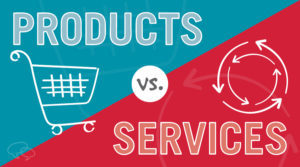
Selling renewable services requires a dramatically different mentality than selling products.
In today’s subscription-minded economy, you’re increasingly likely to find yourself in customer renewal conversations.
Just as your message must change in renewal situations, your mentality must also dramatically differ when selling renewable services versus products. Underappreciation of these realities is one of the most common pitfalls we see in sales teams facing renewal situations on a regular basis.
Three Things New Service Contracts Should Trigger
When selling products, it’s all about the transaction and getting them to buy the product. Once they do, ownership transfers to your customer, you celebrate, it’s done.
When selling subscriptions and renewable services, it’s all about getting adoption. You’ve got to develop the sense that you’re in it together because, with renewable services, your customer is no longer absorbing all the risk. Instead, you now live with the ever-present threat that they’ll leave.
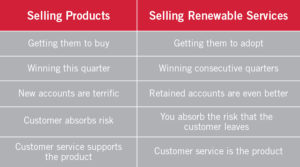
When subscribers initiate a contract, it should trigger three things in your relationship:
Your core metric is to ensure they stay and renew the contract.
You’ve got to sell a lot more when attrition rates are high. As a result, it’s critical to recognize you have a vested interest in your customer’s success so they renew the contract. Return customers also tend to buy more over time, refer you to others, advocate for your brand, and even pay a premium to stay with you rather than switch to an unfamiliar competitor.
Your future opportunities at that account now pivot on the success of the initial deployment.
If your customer doesn’t see the value, not only will they not renew, they’re not going to add users or locations or units either. Whatever the initial subscription, there are usually remaining whitespace opportunities within new accounts. Since new subscribers typically don’t go ‘all in’ on day one, it’s critical you get it right from day one.
Your ultimate goal is now for your customer to help get the message out.
Positive word of mouth creates a viral effect. If you don’t have customers willing to talk about how your services have transformed their business, you won’t reap one of the prime benefits of a successful initial deployment. You could be the best sales professional in the world, but absent reference-able subscribers, everything else is just an unsubstantiated promise.
When selling renewable services, you can’t take customers for granted. Their success is your success, and fully appreciating that requires a different, subscription-minded mentality. If you can ramp up a compelling customer retention story and give your sales team the skills they need to tell that story effectively in the field, you’ll be in a strong position to perform well against your core customer success metric—reducing churn. If you’re hitting your numbers, you have the potential to create a hugely positive ripple effect across your organization.
Want original academic research exploring how to tell the most effective customer retention story? Check out our State of the Conversation Report.
The post Products vs. Services: What Drives Success in a Subscription Economy? appeared first on Corporate Visions.
October 13, 2017
Three Profitability “Moments of Truth” You Need To Address at Your 2018 Sales Kickoff
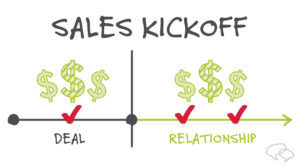
Make this year’s sales kickoff about maximizing profitability throughout the entire customer relationship, not just during the initial deal
Filling the funnel, driving pipeline, and acquiring net-new customers will always be the sexy, swashbuckling side of B2B sales—which is why so many sales kickoffs are overwhelmingly focused on preparing salespeople for success in exactly this stage of the buying cycle. Similarly, when it comes to maximizing profitability, so much sales preparation is skewed toward opportunities to drive profitability during the deal cycle—rather than on all the opportunities reps have to drive profitable growth throughout the life of their accounts.
For your sales kickoff this year, it’s time to think deeper about how you can prepare reps to capture more value both during the deal stage and after it, when your prospects become customers and you need to expand the value of your relationship. With that in mind, I’m going to look at one key moment you need to train for during the deal, and two key moments your reps need to master with customers that are already in the fold.
Moment of Truth #1: Create Pricing Uncertainty During the Deal – McKinsey & Company found that a one percent increase in pricing equates to a nine percent increase in operating margin. When it comes to maximizing profitability during the deal, this finding underscores how crucial it is to employ specific messaging techniques that allow you to expand the scope and size of your discussions. For salespeople in negotiations, that means introducing unconsidered needs—i.e. problems or missed opportunities your prospects haven’t yet considered—to create pricing uncertainty, which de-commoditizes your solutions while expanding the value of—and need for—your offerings. When it comes to capturing more value, this is a far more effective way to protect your pricing and close profitable deals than resorting to traditional late-game negotiation tactics.
Moment of Truth #2: “Why Stay?” – Tell the Right Story for Securing Renewals – If last year’s sales kickoff was all about training your salespeople to challenge and provoke your customers, you were preparing them adequately for acquiring new customers. As for keeping current ones? Not so much. Corporate Visions research shows that applying the same provocative messaging approach that works so well with prospects will actually backfire when it comes to existing customers you’re trying to renew. Despite this, a Corporate Visions industry survey found that nearly 60 percent of companies don’t feel the need to tell a different story for new customer acquisition versus customer retention/expansion.
That’s not good for your growth plans, according to an interesting stat cited in a Harvard Business Review article. The stat asserts that acquiring a new customer is anywhere between five to 25 times more expensive than keeping an existing one. That’s not so surprising when you consider that high startup and support costs can mean customers have to be an active account for months, maybe years, before they become fully profitable. Given the findings from our own research, the renewal story isn’t something companies should just wing. Nor is it a message that should in any way resemble the story you tell to acquire new customers.
Moment of Truth #3: “Why Pay?” – Communicate Price Increases Effectively – Renewals aren’t a conversation you want to take lightly from a structure and strategy standpoint, and the same goes for price increases, which are notoriously tricky and delicate. Unfortunately, many companies are in fact skimping on the messaging rigor in this moment: a Corporate Visions industry survey found that four out of five say they want more direction and guidance around communicating price increases (or the “why pay” story).
Like the renewal conversation, your price increase discussions demand the kind of messaging that’s fundamentally different—even opposite—from the sort of story you tell when prospecting (you can learn about the tested and proven “why pay” messaging framework here). As a result, salespeople need to be trained to understand the unique buyer psychology germane to this critical moment.
What sales kickoff isn’t about maximizing profitability? That’s ultimately why you’re making big investments to bring your sales team together this year. But in 2018, don’t restrict your focus just to early-stage demand generation and pipeline creation—especially at a time when more companies are moving to a products-as-a-service experience, an evolution that’s shifting the pressures and opportunities to other key moments beyond the initial transaction. So, when you talk about capturing value and maximizing profitability at your kickoff this year, remember that you’re talking about much more than just deal-stage pricing negotiations.
Want to learn more about which messages work best for which key buying situations, including the scenarios outlined above? Check out our new eBook: To Challenge or Not To Challenge
The post Three Profitability “Moments of Truth” You Need To Address at Your 2018 Sales Kickoff appeared first on Corporate Visions.
October 2, 2017
“Why Now?” What’s the Best Message For Getting Executive Buyers to Purchase Now?
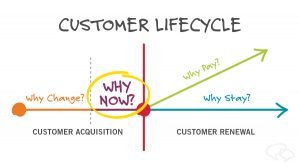
Last year, I helped design a Corporate Visions study that dispelled a big, longstanding myth about executive buyers—which is that they’re strictly analytical or numbers-oriented in their decision-making.
Not so.
In fact, the study revealed that executives are no less susceptible to the appropriate emotionally framed message than anyone else—particularly if that message is framed in terms of what buyers stand to lose by not making a business change instead of what they stand to gain by following through with one.
Specifically, the study found that executives are more than 70 percent more willing to make a risky business decision—such as making a change from their current situation—if you frame their status quo in terms of what they might lose versus what they might gain. In both the loss and gain frame test conditions, the math was equivalent. The words themselves—the story, the messaging—were the only things that differed.
(Read about that research in full here.)
“Why Now?”
That study was a textbook case of loss aversion in action. Loss aversion, along with risk-seeking, is a principle important to Prospect Theory, an idea developed by social psychologists Daniel Kahneman and Amos Tversky which holds that humans are two-to-three times more likely to make a decision to avoid a loss than to make a decision to achieve a gain.
The research clued us into the fact that these principles matter when it comes to having effective conversations with executive and financial decision-makers. It also got us wondering: Why do some business proposals stall out instead of gain momentum and buy-in? What actually creates the urgency to get executive buyers to decide instead of defer?
These questions are the basis for our follow-up study, just completed, which addresses the “why now” moment in the customer conversation—when salespeople (and marketers!) need to be able to create a business proposal that creates urgency and passes muster with executive and financial buyers.
Here’s how we set that study up.
Researching the “Why Now” Moment
For this research, Corporate Visions contracted with Dr. Nick Lee, a professor of marketing at Warwick Business School in Coventry, U.K.
We designed the test conditions and questions to assess several areas critical to this “moment of truth” in the buyer’s journey—areas including confidence in the business proposal, how urgent it was, how essential to future growth, and to what extent it made executives in the study more or less likely to purchase right now.
The study, conducted online, included 312 executive participants, all of whom are employed at companies with $100 million or more in revenues, and all of whom have budget and decision-making responsibilities.
We then asked all participants to imagine they were part of the following business scenario:
You are an executive at a food processing company that cleans, sorts and packages vegetables. You have traditionally served large vegetable products using large-scale equipment that can process several tons of vegetables per hour. However, the most promising growth market is organic and specialty food production, and unfortunately, you do not have equipment suitable for the small batch requirements of this “small-producer” market.
You will be meeting with a company that makes smaller-scale, more flexible equipment that could help you enter this new market, and they present the following story as to why you should buy their equipment.
We then split the executive participants into six different groups, each of which experienced a different messaging test condition, or pitch, that contained different elements of the following:
Business Issue: External factors and business initiatives
Loss: Details about your loss to be avoided
Gain: Details about your potential positive gain
Unconsidered Needs: Introduces an unsuspected threat
Heavy ROI: Hard numbers with a detailed ROI breakdown
Change Story: Business change story with a light ROI component
We then asked all participants the following set of questions about the message condition they experienced, to which they were then asked to assign a numerical rating, between one nine, based on how impactful they believed the message was in each area.
How confident are you that this is a good business decision?
How convincing was the business case as far as getting you to make a decision soon rather than later?
How important is the solution for future success and growth?
How urgent is the need to purchase?
How likely are you to purchase right now?
Results
The most effective message across each of the areas we assessed was structured around presenting a business issue and an unconsidered need before providing a heavy ROI justification. It was the only message condition to finish first in each category. Interestingly, the other message conditions proved to be highly volatile in terms of how they performed in these key areas. In other words, what might have been second or third “best” in one area was dead last in another.
Additionally, the winning condition appears to provide the biggest edge in the two most important areas for the purposes of this study: 1) importance to future success and growth, for which it provides a four percent edge; and 2) likelihood of making a purchase decision right now, for which companies stand to gain a nine percent advantage.
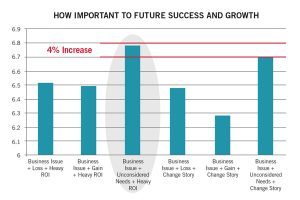
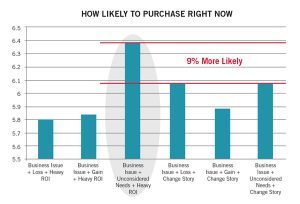
In a post-study analysis, Dr. Lee wrote that the findings of this study are “presented using effect size as the criteria for whether the effect is interesting or not, following the latest opinion in psychological research methods.” He added that a consistent pattern of a “large number of small effects” means that, taken together, “there is a clear argument that [the winning message condition] is more likely to be effective than the others,” and that the unconsidered needs and heavy ROI message “is the way to go” when you’re trying to create urgency and demonstrate business impact in your proposals.
The effectiveness of the message structured around a business issue, an unconsidered need, and a heavy ROI case is consistent with the body of decision-making science research that inspired the study—as well as with our “executive emotions” research. The middle portion of the message—the unconsidered need—can be seen as an extreme form of loss aversion, because it positions their current approach as a loss to be avoided.
This satisfies the emotional, decision-making part of the brain, or what Daniel Kahneman refers to as “System 1” in his book “Thinking Fast and Slow”. Meanwhile, the documented ROI component is consistent with Kahneman’s “System 2,” or neocortex, which supports decision-making. System 2 provides the rationalization and justification of decisions, but does not actually make decisions.
To learn more about the research and see an example of the winning “Why Now” framework, check out the research brief.
The post “Why Now?” What’s the Best Message For Getting Executive Buyers to Purchase Now? appeared first on Corporate Visions.
Timothy Riesterer's Blog
- Timothy Riesterer's profile
- 3 followers



